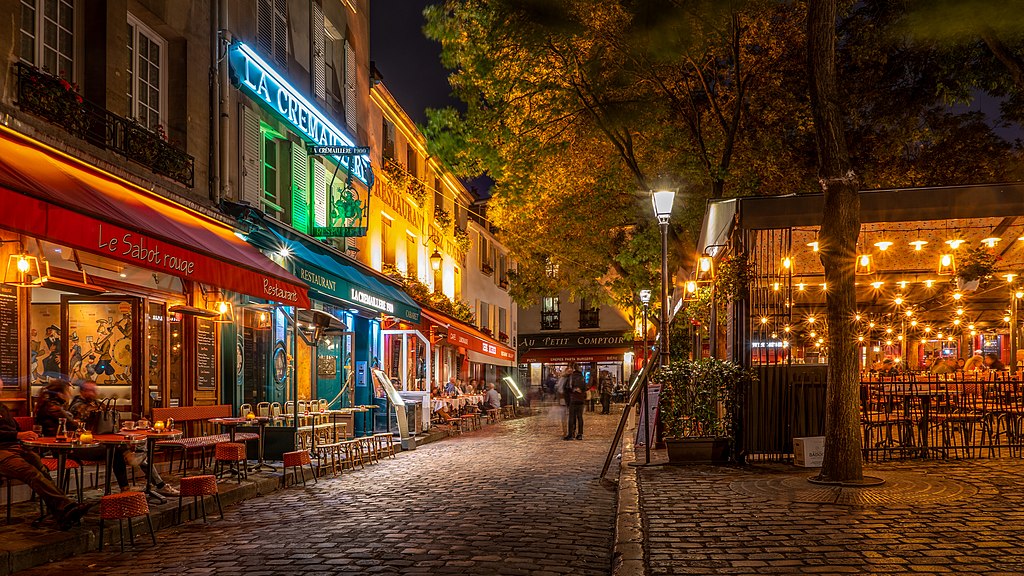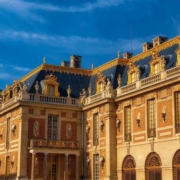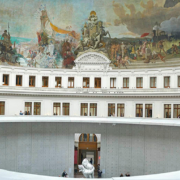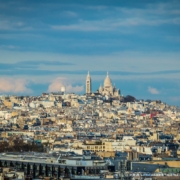Montmartre is the legendary hill of Paris, home to the city’s most recognisable landmarks: the white basilica at the top, the red windmill at the foot, and the streets where Picasso and Dalí once walked. It’s like being in a film – only you’re the star. The walking route and audio guide are waiting for you!
» READ MORE – A stroll through Montmartre with a TouringBee audio guide: you won’t forget it!
If you want to see the sights without crowds and schedules, download our Montmartre audio guide – it’s a self-guided walk with history, audio narration and a built-in map.
Download the Montmartre audio guideIt will take you to the most secluded corners of the district, tell you about artists, cabarets, hidden courtyards and unexpected details that are easy to miss. All this without an internet connection and at your own pace.
Sacré-Cœur Basilica
The white Sacré-Cœur Basilica stands at the highest point in Paris – and seems to guard the entire city. A long staircase leads up to it, where there is always someone playing the guitar, drawing, singing or just sitting with a coffee. And if you climb up to the observation deck in front of the church, almost the whole of Paris will spread out before you.
Inside, there is silence, golden mosaics and the feeling that, outside the windows, life is moving at a completely different pace. Admission is free, but you can climb even higher – up to the dome, if you are not afraid of narrow spiral staircases.
The basilica is visible from many points in the city, but it is truly impressive up close. It is worth coming here at the beginning of your walk: from here, it is convenient to go down and explore the rest of Montmartre’s sights.
Train ride through MontmartreMoulin Rouge Cabaret
The Moulin Rouge is the red windmill at the bottom of the hill, where most people begin their acquaintance with Montmartre. Everything here is authentic: sequins, feathers, cancan – just like a hundred years ago. The venue has been open since the end of the 19th century, and although the audience no longer comes in top hats and gloves, the champagne still flows.
» READ MORE – Moulin Rouge tickets: how to buy them and how much they cost
The show is a spectacular performance with scenery, dancing and the very energy that people still queue up for. If you want to get in, it’s best to book tickets in advance – both for dinner and just for the show.
The prices are steep, but the memories will last for years.
Ticket to the show at the Moulin Rouge cabaretEven if you don’t plan to spend the evening inside, you won’t be able to walk past it. The mill glows both day and night and remains one of the most photographed landmarks in Paris.
Place Pigalle
In third place in terms of popularity is Place Pigalle (la place Pigalle). It’s not so much about beauty as it is about contrasts. Here you will find a mix of cabarets with centuries-old history, souvenir shops, nightclubs, sex shops and tourists with cameras. The neighbourhood was once famous for its vibrant nightlife, and it still hasn’t completely fallen asleep.
During the day, it is noisy and crowded, and in the evening, it is even more active. The area is not the most comfortable for walking with children, but if you are comfortable with eclectic street culture, it is worth a visit. And if you don’t want to linger, you can just walk by and note that Paris is not only about picture-perfect landscapes.
Select a hotel in MontmartreIt can get noisy here in the evening, so we don’t recommend choosing a hotel in this neighbourhood. Although the prices are often very attractive.
Place du Tertre
A landmark for all visitors to Montmartre is the square in front of the former town hall (Place du Tertre) and the old church (Église Saint-Pierre). This is where musicians play, artists paint portraits, mimes pose for the camera, and at the neighbouring table someone leisurely drinks coffee with a croissant. The town hall used to be located here – Montmartre was a separate village, after all – but now the square is exclusively tourist-oriented.
Yes, it is crowded, and yes, the prices in the cafés are inflated, but it is impossible to bypass it.
The atmosphere is a little theatrical, a little cloying, but in a good way: like a stage where everyone has their own role to play. If you want a portrait as a souvenir, haggle. If you just came to look, stay for a couple of minutes and move on to the Church of Saint-Pierre or the Montmartre Museum, which are just around the corner.
The Wall of Love
«I love you» – in two hundred languages, with different accents, handwriting and history. The Wall of Love (Le Mur des Je t’aime) is an art object created by artists Frédéric Baron and Claire Kito. It is hidden in a small square in Montmartre, not far from the bustling Abbesses Square, and is easy to miss if you don’t know what to look for.
The idea behind the piece is that only language stands between people and universal love.
It is not a historical monument or an architectural wonder, but rather a pause between museums and cafés – warm, intimate and unexpectedly touching. Many people come just to take a photo, but some linger to find the cherished words in their own language. It is especially pleasant to visit on a weekday when there are fewer people and you can stand quietly by the wall – without rushing and without queuing.
Bateau-Lavoir
Le Bateau-Lavoir translates as «The Laundry Boat.» It is not a real vessel, but simply a house. It was home to Picasso and a dozen other famous artists at a time when they were still young and poor.
Here, Picasso took his first steps toward the style that would make him famous.
The house got its nickname because of its cramped rooms and residents scurrying through the corridors – it all resembled a ship with cabins one above the other. Such accommodation was cheaper to rent. Today, you cannot enter Bateau-Lavoir, but the street on which it stands still retains a bohemian feel. If you want to see not only postcards but also the place where it all began, it is worth a visit.
The Lapin Agile cabaret
The funny sign with a rabbit running away with a bottle of wine is the Lapin Agile, one of the oldest cabarets in Montmartre. The same artists who lived in Bateau-Lavoir drank, sang and argued here. Some came for wine, some for inspiration, and some simply because there were no other places to go.
The cabaret is still open today, and if you fancy an evening of live French songs in a hall where the wooden tables creak with age, drop in. By the way, you can also try the wine: it comes from vineyards just a stone’s throw away, right on the hillside. Yes, it’s not cheap now. But it comes from the heart of Montmartre.
The Pink House and the Montmartre Museum
The Pink House is another café that has survived in Montmartre since the 19th century. Photos of it are incredibly popular on social media. But we recommend you visit a quieter place – the Renoir Garden. It is located in the courtyard of the Montmartre Museum in the neighbouring building. The museum tells the story of how the hill became a bohemian capital, who invented the cancan, and why Montmartre has always resisted the rest of Paris.
In the museum garden, you can sit by the pond with a glass of wine – a rare opportunity to hide from the hustle and bustle of tourist trails.
Buy tickets in advanceIf you’re lucky, you’ll catch an exhibition. If not, you’ll still get a couple of unexpected stories and a lot of peace and quiet.
By the way, Salvador Dalí also lived in Montmartre among fifty other artists. Now there is a shop-museum in Montmartre with original works by the master (L’Espace Montmartre – Dalí).
The man walking through the wall
In one of the side streets of Montmartre, you will come across a modest attraction – a man stuck in a wall.
Not quite a monument, not quite a joke – it is a sculpture based on a story by the writer Marcel Aymé, a local resident and one of the regulars of Montmartre. He is now buried there, in the Montmartre cemetery. After his death, his friend Jean Marais created a monument in keeping with the title of one of Marcel Aymé’s works, «The Man Who Walked Through Walls». His hero had the ability to walk through walls until one day he got stuck in one forever.
The image conveys both a slight absurdity and Parisian melancholy. Tourists flock to take photos, imitating his pose, while locals simply walk by as if nothing is out of the ordinary. This is very much in the spirit of Montmartre – even the walls here have character.
The Moulin de la Galette
There used to be more than 20 windmills in Montmartre. Today, only two remain. You definitely know one of them – the Moulin Rouge. The second, more modest and authentic, is the Moulin de la Galette. It can be seen through the trees on the slope, just above the Pink House.
In the 19th century, not only the blades turned here, but also the dances: the mill building housed a cabaret frequented by Renoir, Toulouse-Lautrec and Van Gogh. The former even painted a picture of the same name – with Parisians, wine and endless summer.
Now it is a regular café with a nice view, but the mill itself is a reminder that Montmartre was once a village with vineyards, not a tourist magnet. If you walk past it, look up.
» READ MORE – Explore Van Gogh’s Provence
Dalida Monument
There is a tiny square in Montmartre named after the singer Dalida – La place Dalida. She lived nearby, loved the area and walked its streets like any other neighbour – only with worldwide success behind her.
After her death, a bronze bust was erected here, surrounded by photos, plaques, flowers and a constant stream of fans.
The square itself is a quiet corner with a view of the rooftops of Paris. Tourists rarely come here, except out of curiosity or love for her songs. There is an amusing tradition: rubbing the bust’s chest for good luck in love. Judging by the polished metal, many believe in it. Even sceptics usually can’t resist.
St. Jean des Abbesses Catholic Church
Another landmark of Montmartre and Paris is the St. Jean des Abbesses Church. It was built in the 20th century. Despite being a Catholic parish, it looks almost like an Arab palace.
The Church of Saint-Jean de Montmartre is easy to miss, especially if you are walking through the busy Abbesses square. From the outside, it does not resemble a typical church: its brick façade, Art Nouveau stained glass windows and wrought iron details are more reminiscent of an early 20th-century exhibition pavilion than a Catholic church.
It was the first church in Paris to be built using reinforced concrete — an architectural experiment that proved unexpectedly successful.
Inside, it is quiet and intimate. There are almost no tourists, but you get the feeling that you have accidentally discovered something special. It’s a great place to take a break, especially if you’ve come down from Sacré-Cœur.
There are many interesting places to visit in Montmartre. To help you find your way around, we recommend picking up a map at the tourist office, Office de Tourisme. You won’t get lost, and you’ll get a map that’s a real work of art.
The office is located at 21, place du Tertre, and is open from 11:00 to 18:00 from October to April and from 10:00 to 19:00 during the warmer months.
Another way to avoid getting lost is with our audio guide! It’s very interesting, and the built-in map will show you the route even without an internet connection.
Enjoy your trip to Montmartre!









 Jean-Pierre Dalbera / flickr.com / CC BY 2.0
Jean-Pierre Dalbera / flickr.com / CC BY 2.0  Public domain
Public domain 
 Spenser Sembrat / Unsplash
Spenser Sembrat / Unsplash  Daxis / Flickr / CC-BY-ND 2.0
Daxis / Flickr / CC-BY-ND 2.0 Louis Paulin / Unsplash
Louis Paulin / Unsplash
Leave a Reply
Want to join the discussion?Feel free to contribute!